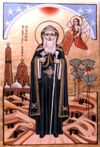Difference between revisions of "Template:Featured"
| Line 1: | Line 1: | ||
<!--- COMMENT ON [[Category_talk:Featured Articles]] TO GET YOUR ARTICLE FEATURED ---><div style="float:left;margin-right:0.9em;"> | <!--- COMMENT ON [[Category_talk:Featured Articles]] TO GET YOUR ARTICLE FEATURED ---><div style="float:left;margin-right:0.9em;"> | ||
| − | [[Image: | + | [[Image:StPakhom.jpg|100px]] |
<!--nb. portrait images at ~100px, landscape images at ~200px--> | <!--nb. portrait images at ~100px, landscape images at ~200px--> | ||
</div> | </div> | ||
| − | ''''' | + | Our venerable father '''''[[Pachomius the Great]]''''' (c. 292-346 A.D.) was an early Egyptian ascetic, both a [[Desert Fathers|Desert Father]] and a founder of [[cenobitic]] [[monasticism]] in Egypt. Pachomius was born to pagan parents in Thebaid (Upper Egypt), receiving an excellent secular education and having a good character from his youth. During his time in the Roman army, he stayed in a prison that was used to house the new conscripts, run by Christians. He was so impressed by their love of their neighbor that he vowed to become a Christian after his military service ended. |
| − | + | Thus in 314 Pachomius was [[baptism|baptized]] and began to practice the ascetic life. Three years later he withdrew to the desert under the guidance of the elder Palamon. According to tradition, after ten years with Palamon he heard a Voice telling him to found a monastic community at Tabbenisi. He and Palamon traveled there, and subsequently Pachomius had a vision in which an angel came to him, clothed in a schema (a type of monastic garment), and gave him a rule for the cenobitic life. This is significant because up until this time ascetics had for the most part lived alone as hermits, not together in a community. Pachomius' rule balanced the communal life with the solitary life; monks live in individual cells but work together for the common good. | |
| − | + | By 348, Pachomius directed almost three thousand monks. This, however, was also the year that he was infected by some form illness. St. Pachomius died around the year 348 at the age of fifty-three, and was buried on a hill near the monastery. St. [[Jerome]] translated the rule of St. Pachomius into Latin in 404, and only this translation survives. The rule of St. Pachomius influenced St. Benedict, the most influential figure in Western monasticism, in preparing his own rule. He is celebrated by the Church on [[May 15]]. | |
'''''Recently featured:''''' [[Chrismation]], [[Sava the New]], [[Russian Orthodox Church Outside Russia]], [[ROCOR and OCA]], [[Pascha]], [[Diocese of Washington and New York (OCA)]], [[Book of Kells]], [[Archangel Gabriel]], [[Alexis of Wilkes-Barre]], [[Theophany]]. ''Newly [[:Category:Featured Articles|featured articles]] are presented on '''Saturdays'''.''<noinclude> | '''''Recently featured:''''' [[Chrismation]], [[Sava the New]], [[Russian Orthodox Church Outside Russia]], [[ROCOR and OCA]], [[Pascha]], [[Diocese of Washington and New York (OCA)]], [[Book of Kells]], [[Archangel Gabriel]], [[Alexis of Wilkes-Barre]], [[Theophany]]. ''Newly [[:Category:Featured Articles|featured articles]] are presented on '''Saturdays'''.''<noinclude> | ||
[[Category:Main page templates|Featured]]</noinclude> | [[Category:Main page templates|Featured]]</noinclude> | ||
Revision as of 19:41, April 5, 2008
Our venerable father Pachomius the Great (c. 292-346 A.D.) was an early Egyptian ascetic, both a Desert Father and a founder of cenobitic monasticism in Egypt. Pachomius was born to pagan parents in Thebaid (Upper Egypt), receiving an excellent secular education and having a good character from his youth. During his time in the Roman army, he stayed in a prison that was used to house the new conscripts, run by Christians. He was so impressed by their love of their neighbor that he vowed to become a Christian after his military service ended.
Thus in 314 Pachomius was baptized and began to practice the ascetic life. Three years later he withdrew to the desert under the guidance of the elder Palamon. According to tradition, after ten years with Palamon he heard a Voice telling him to found a monastic community at Tabbenisi. He and Palamon traveled there, and subsequently Pachomius had a vision in which an angel came to him, clothed in a schema (a type of monastic garment), and gave him a rule for the cenobitic life. This is significant because up until this time ascetics had for the most part lived alone as hermits, not together in a community. Pachomius' rule balanced the communal life with the solitary life; monks live in individual cells but work together for the common good.
By 348, Pachomius directed almost three thousand monks. This, however, was also the year that he was infected by some form illness. St. Pachomius died around the year 348 at the age of fifty-three, and was buried on a hill near the monastery. St. Jerome translated the rule of St. Pachomius into Latin in 404, and only this translation survives. The rule of St. Pachomius influenced St. Benedict, the most influential figure in Western monasticism, in preparing his own rule. He is celebrated by the Church on May 15.
Recently featured: Chrismation, Sava the New, Russian Orthodox Church Outside Russia, ROCOR and OCA, Pascha, Diocese of Washington and New York (OCA), Book of Kells, Archangel Gabriel, Alexis of Wilkes-Barre, Theophany. Newly featured articles are presented on Saturdays.
